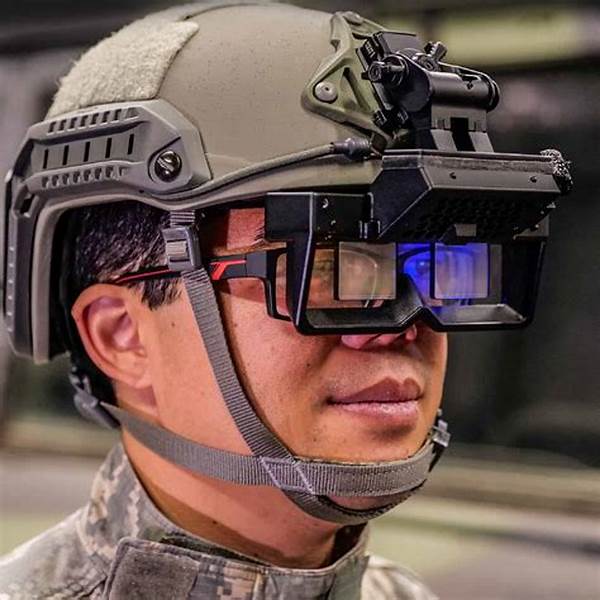Introduction to Combat-Ready AR Display Technologies
In recent years, Augmented Reality (AR) has emerged as a transformative force in various industries, including defense. The concept of combat-ready AR display technologies encompasses the integration of sophisticated AR systems into military operations. These systems are designed to enhance situational awareness, provide real-time data overlay, and improve decision-making processes for military personnel. The fundamental aim of these technologies is to provide soldiers with critical information while minimizing distractions, ultimately improving operational efficiency and effectiveness.
Combat-ready AR display technologies offer a myriad of applications within the military context. From heads-up displays (HUDs) in fighter aircraft to ground troop helmets embedded with real-time mapping and target acquisition capabilities, these technologies are revolutionizing the way military missions are conducted. Advanced AR systems enable soldiers to access crucial information such as enemy positions, troop movements, and environmental conditions, thereby facilitating better strategic planning and execution.
The implementation of combat-ready AR display technologies is not without challenges. Issues such as data security, system reliability, and user adaptability need to be addressed to fully harness the potential of these technologies. Despite these challenges, ongoing research and development efforts continue to drive innovation in the field, promising a future of enhanced military capabilities through advanced augmented reality systems.
Key Features of Combat-Ready AR Display Technologies
1. Combat-ready AR display technologies integrate seamlessly into existing military systems, offering enhanced interoperability and streamlined operations.
2. The technologies provide real-time data overlay for improved situational awareness, allowing soldiers to make informed decisions based on augmented reality visuals.
3. Advanced imaging and targeting capabilities are key components, enabling precise identification and engagement of targets in complex operational environments.
4. User-friendly interfaces are critical in combat-ready AR display technologies, ensuring that military personnel can operate systems efficiently under pressure.
5. Continuous innovation and development are essential to address the dynamic needs of modern warfare, ensuring combat-ready AR display technologies remain at the forefront of military advancements.
Applications of Combat-Ready AR Display Technologies in Defense
Combat-ready AR display technologies have found significant applications in the defense sector. These technologies are pivotal in modernizing military operations and enhancing tactical capabilities on the battlefield. One notable application is in the realm of heads-up displays (HUDs) used by pilots. By integrating augmented reality, HUDs provide pilots with critical flight and mission data directly in their line of sight, reducing the need to glance away from the flight path.
Ground forces also benefit from combat-ready AR display technologies through advanced helmet-mounted displays. These systems offer real-time mapping, navigation assistance, and enhanced target identification capabilities, all critical for mission success. The ability to overlay live data onto the physical environment allows soldiers to execute complex operations with greater precision and coordination. Such innovations underscore the transformative role of augmented reality within modern military strategies.
Challenges and Opportunities in Combat-Ready AR Display Technologies
1. Combat-ready AR display technologies must overcome data security concerns to prevent unauthorized access and ensure mission critical information remains protected.
2. System reliability is paramount in combat-ready AR display technologies, as any malfunction could jeopardize mission success and operator safety.
3. The effective integration of these technologies into military operations requires a focus on user adaptability and training, ensuring personnel can utilize them proficiently.
4. Continued innovation presents opportunities to enhance the scope and capabilities of combat-ready AR display technologies, offering greater advantages to military units.
5. Global collaboration and information sharing can accelerate advancements and standardization in combat-ready AR display technologies, benefiting nations and allies.
6. Addressing the high development and implementation costs is necessary for broader adoption and deployment of combat-ready AR display technologies.
7. Ethical considerations must be addressed to ensure that combat-ready AR display technologies are used in alignment with international humanitarian laws and guidelines.
8. Combat-ready AR display technologies should incorporate robust testing and validation processes to meet the rigorous demands of military applications.
9. Improvements in battery life and energy efficiency are needed to ensure sustained operation during extended missions.
10. Incorporation of artificial intelligence within combat-ready AR display technologies could further enhance their capabilities, offering predictive analytics and decision support.
The Future of Combat-Ready AR Display Technologies
As we look to the future, the role of combat-ready AR display technologies in military operations is poised to expand significantly. Emerging advancements in augmented reality promise to further enhance the tactical edge of armed forces. The integration of artificial intelligence and machine learning into AR systems stands to revolutionize data processing and analysis, enabling more intelligent decision-making on the battlefield. Additionally, improvements in hardware, such as lighter and more energy-efficient displays, will make these technologies more accessible and effective for frontline personnel.
Collaboration between military agencies, technology developers, and research institutions will play a critical role in driving innovation in the field of combat-ready AR display technologies. This cooperation is essential in surmounting existing challenges and unlocking the full potential of AR for defense. As these systems become more sophisticated, there will be a growing need for comprehensive training programs to ensure that military personnel can maximize the benefits of augmented reality technology in high-pressure environments.
Strategic Implications of Combat-Ready AR Display Technologies
The strategic implications of combat-ready AR display technologies are profound, offering significant advantages for military operations. By providing enhanced situational awareness and real-time data, these technologies ensure that commanders and field operatives can make informed decisions swiftly, achieving operational objectives more effectively. The ability to visualize environmental conditions, troop movements, and potential threats through augmented reality fosters better coordination and precision in conflict scenarios.
Moreover, combat-ready AR display technologies serve as force multipliers, amplifying the capabilities of individual soldiers and units. As warfare continues to evolve with the introduction of new technologies, the integration of AR into military systems offers a sustainable path to maintaining tactical superiority. Nations investing in the development and deployment of these technologies will likely gain a strategic advantage, reinforcing the importance of continued focus and innovation in this domain.
Conclusion on Combat-Ready AR Display Technologies
In summary, combat-ready AR display technologies represent a pivotal advancement in military operational capabilities. Their ability to enhance situational awareness, provide real-time information, and improve decision-making processes makes them a crucial component of modern defense strategies. Despite challenges such as data security and system reliability, the potential benefits of these technologies are immense, driving ongoing research and development efforts.
The future of combat-ready AR display technologies is promising, with continued innovation poised to expand their applications and effectiveness. As military forces worldwide seek to modernize and gain tactical advantages, the integration of augmented reality systems will play an increasingly vital role. Collaboration and strategic investments will be key in ensuring that these technologies are not only adopted but also leveraged to their fullest potential, marking a new era in military operations.





